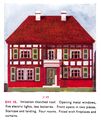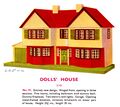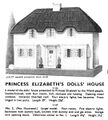Category:Dollhouses
1902: Gamages catalogue "Doll Mansion", with "Nuremberg" indicator on artwork [image info]
1906: Gamages Dollhouse No.7 [image info]
1922: Titania's Palace opens to the public [image info]
1937: Tri-ang Ultra-Modern Dollhouse, No.52 [image info]
Hobbies Tudor Dollhouse plans [image info]
1956: Advert for Romside dollhouse fittings [image info]
"Dolls' Houses" and "Dollhouses" are "play houses" that usually consist of a self-contained house of two or more stories, with one or more exterior walls that hinge open to reveal the rooms inside. In the interests of compatibility, dollhouses are usually made to standard scales, most commonly 1:12 (known as "dollhouse scale"), or the smaller 1:16.
Origins
C17th
Although the history of model buildings (built for various purposes) will is obviously go back to time immemorial, the European tradition of the "doll house" is generally considered to have started in Southern Germany in around ~1600, with a baby house commissioned by the Duke of Bavaria.
These early "baby houses" tended to be furnished rooms built into a cabinet on legs, as a piece of furniture, without necessarily having the external appearance of a house, although Anna Köferlin's 1631 baby-house", built and exhibited as a training tool for domestic management, does appear from the surviving flyers, to have been house-shaped. Four houses from this period are supposed to be at the Germanishes National Museum.
C18th
In the Eighteenth Century, dollhouses became a fashionable status symbol for wives of wealthy Dutch merchants, as the Dutch trading empire brought riches into the country along with precious metals, creating work for jewellers and craftsmen who could then be employed to create dollhouse miniatures.
C20th
In Britain and Ireland, interest in dollhouses was boosted in the 1920s by the "launch" of two high-profile famous houses which were then displayed at exhibitions, first Titania's Palace, which was finally finished in 1922 and then went on tour, and then by the appearance of Queen Mary's Dolls' House, which was started in 1920 and finished in 1924, and went on show at the British Empire Exhibition and Ideal Home Exhibition, and then went on display in a specially constructed space at Windsor Castle.
Dolls houses vs. dollhouses
A common subject of confusion is whether an example is intended as a doll's house or a dollhouse.
- Doll's Houses or Dolls' Houses are houses built "for dolls". The intention is that the dolls are played with, and the house represents a backdrop and context for the play. Dolls houses tend to be aimed at children.
- With a Doll house, on the other hand, the house itself is the "doll" - it is a "toy house", rather than a house meant to be lived in by toys.
Dollhouses can be a very serious matter. A dollhouse is often entirely devoid of dolls, as it's for the owner, who gets the satisfaction of furnishing and decorating it at a fraction of the cost of furnishing and decorating a real building.
A good example of this is the famous 1924 Queen Mary dollhouse - although titled as a "doll's house", the house has an emphatic absence of dolls - it is a model of a house and it's furnishings, created to the highest modelmaking and engineering accuracy possible, and contaminating the interior with a human doll would not only violate its design rules of utter authenticity in construction and materials, it would visually break the illusion that we were looking at the interior of a real house. The house contains grudging signs of life in the form of a small cat and some mice (and a snail in the garden), but that's it – no dolls allowed!
See also:
External links
- Dolls' Houses Past & Present. A website and ezine about dolls' houses: antique, vintage and modern. Plus furniture and accessories. (dollshousespastandpresent.com) – a ridiculously thorough site that acts as a "one-stop shop" and clearing house for information on dollhouses, dolls' houses and dollhouse miniatures.
- A 19th Century Dolls’ House: Designed to Dazzle (historymagpie.com)
- Dolls' houses: it's a small world (theguardian.com)
historical
- The Munich Baby House (cdhm.org)
- Germanisches National Museum (www.gnm.de/en/)
- C17th Dutch Kitchen, Victoria and Albert Museum (vam.ac.uk)
on public display
- Beatrix Potter House (nationaltrust.org.uk)
- Uppark House (nationaltrust.org.uk)
- Morden Hall Park (nationaltrust.org.uk)
- Nostell Priory and Parkland (nationaltrust.org.uk)
- Saltram, Devon (nationaltrust.org.uk)
- Sudburry and Museum of Childhood, Derbyshire (nationaltrust.org.uk)
- V&A Museum of Childhood (vam.ac.uk)
- Hove Museum (brightonmuseums.org.uk)
- Model Museum in Wales (tytwtdollshouseandtoymuseum.org.uk)
- Toy Museum Isle of Wight (lilliputmuseum.co.uk)
- The Dolly Lodge (jeyesofearlsbarton.co.uk)
- My Little World (mylittleworld.co.uk)
- (baccraftminiatures.com)
- Doll’s House (Furniture) shop (maplestreet.co.uk)
- French Toy Museum (Colmar) (museejouet.com)
- Toy Museum Brussels (museedujouet.eu)
- Toy Museum France, Pezenas (museedujouetpezenas.com)
- Toy Museum Belgium (musee-du-jouet-ancien.com)
magazines
- Dolls House and Miniature Scene magazine, monthly (hobbies-and-crafts.co.uk) – (Facebook)
- The Dolls' House Magazine (thegmcgroup.com) – (Twitter)
- Dollshouse World (dollshouseworld.com) – (Facebook)
shops
modern
Subcategories
This category has the following 17 subcategories, out of 17 total.
B
D
- Dolly Varden dollhouse (5 F)
F
G
- Gamages dollhouses (19 F)
H
- Hobbies dollhouses (1 P, 9 F)
J
- Jennys Home room box system (4 P, 23 F)
M
- Metal Dollhouse, (Mettoy 6254) (empty)
- Mirror Grange (6 P, 11 F)
- Modelcraft dollhouse plans (5 F)
- Märklin Bathroom (11 F)
- Märklin Kitchen (1 P, 28 F)
N
S
- Spot-On dollhouse fittings (5 P, 8 F)
T
- Tri-ang dollhouses (7 P, 32 F)
Pages in category ‘Dollhouses’
The following 11 pages are in this category, out of 11 total.
Media in category ‘Dollhouses’
The following 82 files are in this category, out of 82 total.
- A dolls house you can assemble in one evening, Philip Hamer (HWMag 1960-12).jpg 1,617 × 2,200; 465 KB
- Building Model Houses, Hobbies no1953 (HW 1933-03-25).jpg 1,801 × 2,500; 3.26 MB
- Bungalow Plan, dollhouse, Modelcraft GB106 (MCList 1951).jpg 1,301 × 1,249; 673 KB
- Conversion Plan, dollhouse, Modelcraft GB107 (MCList 1951).jpg 1,292 × 1,470; 639 KB
- Cottage Plan, dollhouse, Modelcraft GB108 (MCList 1951).jpg 1,186 × 1,059; 513 KB
- Detail, Metal Dollhouse (Mettoy 6254).jpg 3,000 × 2,000; 1.05 MB
- Dining Room and Lounge (Kleeware and Mettoy, 1950s).jpg 3,000 × 1,690; 637 KB
- Doll Mansion, Nuremberg (Gamages 1902).jpg 2,961 × 2,123; 1.41 MB
- Dollhouse (Gamages 1914).jpg 2,457 × 2,915; 795 KB
- Dollhouse 23 The Corner House, G and J Lines (Gamages 1906).jpg 1,185 × 1,621; 526 KB
- Dollhouse and Miniatures shops (UK).jpg 644 × 643; 91 KB
- Dollhouse No1, Gamages (Gamages 1906).jpg 1,431 × 1,922; 632 KB
- Dollhouse No1358 (Gamages 1902).jpg 1,786 × 2,011; 774 KB
- Dollhouse No2, Villa, Gamages (Gamages 1906).jpg 1,419 × 1,906; 631 KB
- Dollhouse No3, Villa, Gamages (Gamages 1906).jpg 1,438 × 2,068; 719 KB
- Dollhouse No4, Villa, Gamages (Gamages 1906).jpg 1,557 × 2,025; 908 KB
- Dollhouse No5, Villa, Gamages (Gamages 1906).jpg 1,465 × 1,976; 875 KB
- Dollhouse No6, Villa, Gamages (Gamages 1906).jpg 1,465 × 1,993; 809 KB
- Dollhouse No7, Villa, Gamages (Gamages 1906).jpg 1,873 × 2,188; 1.17 MB
- Dollhouse No8, Villa, Gamages (Gamages 1906).jpg 1,856 × 2,204; 963 KB
- Dollhouse Plans, Hobbies no1828 (HW 1930-11-01).jpg 1,803 × 2,500; 3.53 MB
- Dollhouse Plans, Modelcraft (MCMag 1948-03).jpg 1,315 × 2,000; 1.37 MB
- Dollhouse with garage (kit-built, probably Romside).jpg 2,000 × 1,123; 1.11 MB
- Dollhouse, Bassett-Lowke (HW 1932-12-10).jpg 2,000 × 640; 353 KB
- Dolls Bungalow, Hobbies Weekly 3643 (HW 1965-10-06).jpg 989 × 1,200; 362 KB
- Dolls House No10, Tri-ang 3149 (TriangCat 1937).jpg 1,985 × 2,365; 923 KB
- Dolls House No12, Tri-ang 3150 (TriangCat 1937).jpg 2,933 × 2,773; 1.65 MB
- Dolls House No20, Tri-ang 3129 (TriangCat 1937).jpg 1,690 × 2,006; 464 KB
- Dolls House No21, Tri-ang 3130 (TriangCat 1937).jpg 1,657 × 2,117; 488 KB
- Dolls House No22, Tri-ang 3131 (TriangCat 1937).jpg 1,721 × 2,241; 656 KB
- Dolls House No23, Tri-ang 3132 (TriangCat 1937).jpg 1,471 × 1,913; 477 KB
- Dolls House No24, Tri-ang 3133 (TriangCat 1937).jpg 1,798 × 2,280; 738 KB
- Dolls House No45, Tri-ang 3134 (TriangCat 1937).jpg 2,227 × 2,061; 759 KB
- Dolls House No49, Ultra Modern, Tri-ang 3135 (TriangCat 1937).jpg 1,301 × 1,480; 338 KB
- Dolls House No50, Ultra Modern, Tri-ang 3136 (TriangCat 1937).jpg 1,743 × 1,613; 420 KB
- Dolls House No51, Ultra Modern, Tri-ang 3137 (TriangCat 1937).jpg 1,969 × 1,477; 454 KB
- Dolls House No52, Ultra Modern, Tri-ang 3138 (TriangCat 1937).jpg 2,146 × 1,726; 621 KB
- Dolls House No53, Ultra Modern, Tri-ang 3139 (TriangCat 1937).jpg 2,489 × 1,802; 751 KB
- Dolls House No60 Tri-ang 3140 (TriangCat 1937).jpg 2,826 × 2,060; 863 KB
- Dolls House No61 Tri-ang 3141 (TriangCat 1937).jpg 3,241 × 2,131; 1.1 MB
- Dolls House No80, Large Country House, Tri-ang 3148 (TriangCat 1937).jpg 2,344 × 2,545; 1.02 MB
- Dolls House No91, Tri-ang 3143 (TriangCat 1937).jpg 2,898 × 2,594; 1.07 MB
- Dolls House No92, Tri-ang 3144 (TriangCat 1937).jpg 2,185 × 2,651; 904 KB
- Dolls House No93, Tudor Stockbroker Tri-ang 3145 (TriangCat 1937).jpg 4,771 × 2,171; 1.84 MB
- Dolls House, Frederic Aldis (TLFCS 1898-12-03).jpg 1,328 × 1,307; 852 KB
- Gable Roof Dollhouse no14 no225 (Gamages 1902).jpg 1,168 × 1,798; 498 KB
- Gottschalk dollhouse, corner, showing wear and construction details.jpg 1,800 × 1,255; 1.33 MB
- Gottschalk Dollhouse.jpg 1,037 × 1,600; 1.01 MB
- Handsome Dollhouse (Gamages 1902).jpg 1,993 × 2,261; 1.11 MB
- Handsome Dollhouse (Gamages 1914).jpg 2,216 × 2,552; 604 KB
- Handsome Villa (Gamages 1914).jpg 2,185 × 2,565; 687 KB
- Hobbies 1966 Annual, cover.jpg 1,187 × 1,600; 419 KB
- Hobbies 1983 Handbook, cover.jpg 1,131 × 1,600; 434 KB
- Hobbies Annual 1967, cover.jpg 1,266 × 1,600; 471 KB
- Improved Dollhouse (Gamages 1902).jpg 3,629 × 1,902; 996 KB
- Metal Dollhouse and plastic furniture (Mettoy).jpg 3,000 × 2,137; 999 KB
- Philip Hamer dollhouse exterior (HWMag 1960-12).jpg 2,200 × 1,665; 599 KB
- Philip Hamer dollhouse, interior (HWMag 1960-12).jpg 2,200 × 1,458; 521 KB
- Philip Hamer dollhouse, step 1 (HWMag 1960-12).jpg 1,200 × 861; 200 KB
- Philip Hamer dollhouse, step 2 (HWMag 1960-12).jpg 1,200 × 900; 276 KB
- Philip Hamer dollhouse, step 3 (HWMag 1960-12).jpg 1,200 × 866; 305 KB
- Pixie Post House, Hobbies Weekly 3448 (HW 1962-01-10).jpg 922 × 1,200; 313 KB
- Princess Elizabeths Dolls House (Tri-Ang 3146).jpg 2,000 × 1,334; 1.7 MB
- Princess Elizabeths Dolls House (Triang 3146).jpg 1,079 × 1,200; 223 KB
- Princess Elizabeths Dolls House, Tri-ang 3146 3147 (TriangCat 1937).jpg 2,633 × 2,865; 1.19 MB
- Romside dolls house fittings trade advert (GaT 1956).jpg 1,600 × 1,251; 903 KB
- Spire, Gottschalk dollhouse.jpg 1,200 × 1,199; 587 KB
- Stockbroker dollhouse, Triang 72 93, restored exterior (Jen Spencer).jpg 640 × 427; 190 KB
- Superior Model Dollhouse (Gamages 1914).jpg 2,165 × 2,889; 621 KB
- Superior Quality Dollhouse (Gamages 1902).jpg 2,102 × 1,613; 850 KB
- Triang Dollhouse No60 with porch (GXB 1932).jpg 1,224 × 1,804; 472 KB
- Triang Dollhouse No61 with garage (GXB 1932).jpg 1,804 × 1,174; 494 KB
- Triang Dollhouse No62 with garage (GXB 1932).jpg 1,662 × 1,438; 498 KB
- Triang Dollhouse No70 (GXB 1932).jpg 1,344 × 1,925; 479 KB
- Triang Dollhouse No71 with garage (GXB 1932).jpg 1,894 × 1,229; 475 KB
- Triang Dollhouse No72 with garage (GXB 1932).jpg 1,735 × 1,407; 504 KB
- Triang Dollhouse, Elfin (GXB 1932).jpg 1,120 × 1,700; 422 KB
- Triang No 65 dollhouse, on display.jpg 3,000 × 1,689; 619 KB
- Tudor Dolls House design (Hobbies Special Fretwork Design No.186).jpg 650 × 1,024; 153 KB
- Tudor-style dollhouse (Hobbies No186 Special).jpg 1,600 × 1,303; 1.07 MB
- William and Mary House Plan, dollhouse, Modelcraft GA103 (MCList 1951).jpg 1,290 × 1,018; 526 KB


























































































